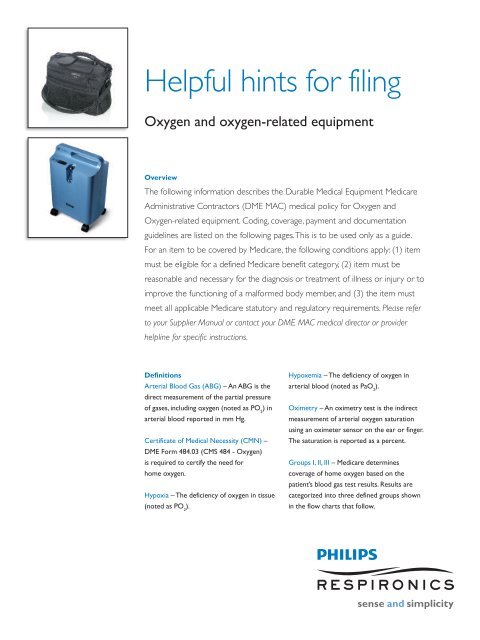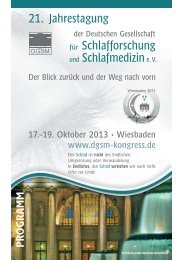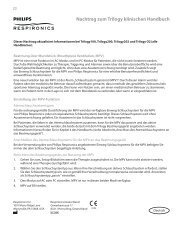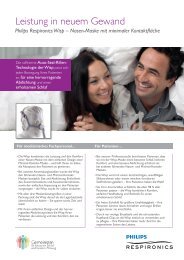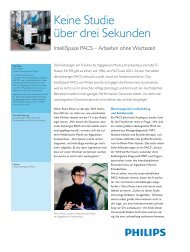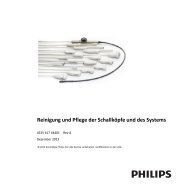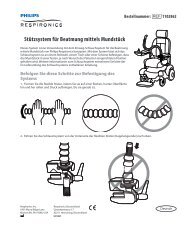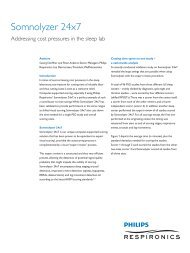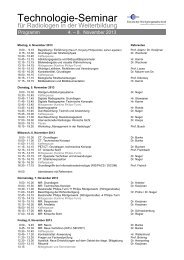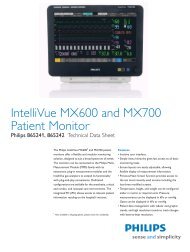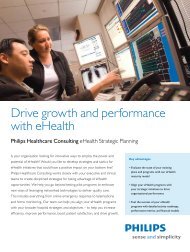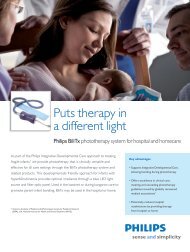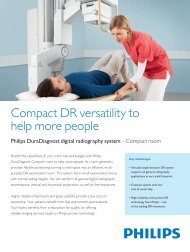Helpful hints for filing - Philips Healthcare
Helpful hints for filing - Philips Healthcare
Helpful hints for filing - Philips Healthcare
You also want an ePaper? Increase the reach of your titles
YUMPU automatically turns print PDFs into web optimized ePapers that Google loves.
<strong>Helpful</strong> <strong>hints</strong> <strong>for</strong> <strong>filing</strong><br />
Oxygen and oxygen-related equipment<br />
Mary Coughlin RN, MS, NNP, Global Clinical Services Managers, Children’s Medical Ventures<br />
Overview<br />
The following in<strong>for</strong>mation describes the Durable Medical Equipment Medicare<br />
Administrative Contractors (DME MAC) medical policy <strong>for</strong> Oxygen and<br />
Oxygen-related equipment. Coding, coverage, payment and documentation<br />
guidelines are listed on the following pages. This is to be used only as a guide.<br />
For an item to be covered by Medicare, the following conditions apply: (1) item<br />
must be eligible <strong>for</strong> a defined Medicare benefit category, (2) item must be<br />
reasonable and necessary <strong>for</strong> the diagnosis or treatment of illness or injury or to<br />
improve the functioning of a mal<strong>for</strong>med body member, and (3) the item must<br />
meet all applicable Medicare statutory and regulatory requirements. Please refer<br />
to your Supplier Manual or contact your DME MAC medical director or provider<br />
helpline <strong>for</strong> specific instructions.<br />
Definitions<br />
Arterial Blood Gas (ABG) – An ABG is the<br />
direct measurement of the partial pressure<br />
of gases, including oxygen (noted as PO 2<br />
) in<br />
arterial blood reported in mm Hg.<br />
Certificate of Medical Necessity (CMN) –<br />
DME Form 484.03 (CMS 484 - Oxygen)<br />
is required to certify the need <strong>for</strong><br />
home oxygen.<br />
Hypoxia – The deficiency of oxygen in tissue<br />
(noted as PO 2<br />
).<br />
Hypoxemia – The deficiency of oxygen in<br />
arterial blood (noted as PaO 2<br />
).<br />
Oximetry – An oximetry test is the indirect<br />
measurement of arterial oxygen saturation<br />
using an oximeter sensor on the ear or finger.<br />
The saturation is reported as a percent.<br />
Groups I, II, III – Medicare determines<br />
coverage of home oxygen based on the<br />
patient’s blood gas test results. Results are<br />
categorized into three defined groups shown<br />
in the flow charts that follow.
General coverage guidelines<br />
Home oxygen is covered and paid by Medicare if the<br />
following conditions are met:<br />
1. The patient has a severe lung disease or hypoxiarelated<br />
symptoms that the physician has determined<br />
may improve with oxygen therapy.<br />
2. The patient’s blood gas study meets qualifying oxygen<br />
levels.<br />
3. The treating physician tried or considered alternative<br />
treatment measures and determined them to be<br />
ineffective.<br />
Qualifying arterial blood gas studies<br />
• The term ‘blood gas study’ in this <strong>Helpful</strong> Hints refers<br />
to both an ABG test and an oximetry test.<br />
• A qualified physician, laboratory, or independent<br />
diagnostic testing facility (IDTF) must per<strong>for</strong>m the blood<br />
gas study. A DME supplier may not per<strong>for</strong>m or pay <strong>for</strong><br />
the qualifying blood gas study (this exclusion does not<br />
apply to blood gas studies per<strong>for</strong>med by a hospital<br />
certified to do tests).<br />
• If an ABG and an oximetry test are both per<strong>for</strong>med<br />
on the same day under the same conditions (i.e., at<br />
rest/awake, during exercise, or during sleep), report the<br />
PO 2<br />
from the ABG on the CMN. If the ABG PO 2<br />
result<br />
at rest (awake) is not a qualifying value, but an exercise<br />
or sleep oximetry test on the same day is qualifying, the<br />
oximetry test will be used to determine coverage.<br />
• If an oximetry measurement is taken during sleep, the<br />
patient must meet the qualifying oxygen saturation level<br />
<strong>for</strong> at least five minutes. The qualifying five-minute<br />
reading does not have to be continuous.<br />
• The qualifying study may be per<strong>for</strong>med while the patient<br />
is on oxygen as long as the reported blood gas values<br />
meet the Group I or Group II criteria.<br />
• Medicare has the discretion to request a repeat blood<br />
gas at any time.<br />
The blood gas study must be per<strong>for</strong>med according to the<br />
following guidelines:<br />
1. The qualifying blood gas study is per<strong>for</strong>med by a<br />
physician or by a qualified provider or supplier of<br />
laboratory services.<br />
2. If the test is per<strong>for</strong>med during an inpatient hospital stay,<br />
the reported test must be the test per<strong>for</strong>med closest<br />
to, but no earlier than, two days prior to the discharge.<br />
3. If the test is not per<strong>for</strong>med during an inpatient hospital<br />
stay, the reported test must be per<strong>for</strong>med while the<br />
patient is in a chronic stable state (not during an acute<br />
illness or exacerbation of their underlying disease).<br />
4. For sleep oximetry studies, the oximeter provided to<br />
the patient must be tamperproof and must have the<br />
capability to download data that allows documentation<br />
of the duration of oxygen desaturation below a<br />
specific value.<br />
Home sleep oximetry studies<br />
Beneficiaries may self-administer home-based overnight<br />
oximetry tests under the direction of a Medicare-enrolled<br />
Independent Diagnostic Testing Facility (IDTF). A DME<br />
supplier or another shipping entity may deliver a pulse<br />
oximetry test unit and related technology used to collect<br />
and transmit test results to the IDTF, to a beneficiary’s<br />
home under the following circumstances:<br />
1. The beneficiary’s treating physician has ordered an<br />
overnight pulse oximetry test be<strong>for</strong>e the test is<br />
per<strong>for</strong>med.<br />
2. The test is per<strong>for</strong>med under the direction and/or<br />
instruction of a Medicare-approved IDTF. Because it<br />
is the beneficiary who self-administers this test, the<br />
IDTF must provide clear written instructions to the<br />
beneficiary on proper operation of the test equipment<br />
and must include access to the IDTF in order to<br />
address other concerns that may arise. The DME<br />
supplier may not create this written instruction,<br />
provide verbal instructions, answer questions from<br />
the beneficiary, apply or demonstrate the application of<br />
the testing equipment to the beneficiary, or otherwise<br />
participate in the conduct of the test.<br />
3. The test unit is sealed and tamper-proof such that test<br />
results cannot be accessed by anyone other than the<br />
IDTF who is responsible <strong>for</strong> transmitting a test report<br />
to the treating physician. The DME supplier may use<br />
related technology to download test results from the<br />
testing unit and transmit those results to the IDTF. In<br />
no case may the DME supplier access or manipulate<br />
the test results in any <strong>for</strong>m.<br />
The IDTF must send the test results to the physician.<br />
The IDTF may send the test results to the supplier if<br />
the supplier is currently providing, or has an order to<br />
provide, oxygen or other respiratory services to the<br />
beneficiary or if the beneficiary has signed a release<br />
permitting the supplier to receive the report.<br />
Oximetry test results obtained through a similar process<br />
while the beneficiary is awake, either at rest or with<br />
exercise, may not be used <strong>for</strong> purposes of qualifying the<br />
beneficiary <strong>for</strong> home oxygen therapy.
Medicare determines coverage of home oxygen based on the patient’s blood gas test results. Results are<br />
categorized into three defined groups shown in the following flow charts.<br />
Group I<br />
Patient has arterial PO 2<br />
≤ 55 mm Hg<br />
OR arterial oxygen saturation ≤ 88%<br />
taken at rest (awake).<br />
Yes<br />
or<br />
Patient has arterial PO 2<br />
≤ 55 mm<br />
Hg OR arterial oxygen saturation ≤<br />
88% <strong>for</strong> at least 5 minutes, taken during<br />
sleep AND demonstrates arterial PO 2<br />
≥ 56 mm Hg OR arterial oxygen<br />
saturation ≥ 89% while awake.<br />
or<br />
Patient has a decrease in arterial<br />
PO 2<br />
>10 mm Hg, OR a decrease in<br />
arterial oxygen saturation >5%, <strong>for</strong> at<br />
least 5 minutes, taken during sleep that<br />
is associated with symptoms<br />
attributable to hypoxemia.<br />
or<br />
Yes<br />
Yes<br />
Patient meets the Group I criteria.<br />
Initial coverage is limited to 12 months<br />
OR other length of need if specified by<br />
the physician, whichever is shorter.<br />
Patient has arterial PO 2<br />
≤ 55 mm<br />
Hg OR arterial oxygen saturation<br />
≤ 88% taken during exercise AND<br />
demonstrates arterial PO 2<br />
≥56 mm<br />
Hg OR arterial oxygen saturation<br />
≥ 89% during the day while at rest.*<br />
Yes<br />
* In this case, oxygen is provided <strong>for</strong> during exercise if it is documented<br />
that the use of oxygen improves the hypoxemia that was demonstrated<br />
during exercise when the patient was breathing room air.<br />
Group II<br />
Patient has arterial PO 2<br />
of 56-59 mm Hg OR an<br />
arterial blood oxygen saturation of 89% at rest<br />
(awake), during sleep <strong>for</strong> at least 5 minutes, OR during<br />
exercise (as described under Group I criteria).<br />
and one of the following<br />
Patient has dependent edema suggesting congestive<br />
heart failure.<br />
Yes<br />
or<br />
Patient has pulmonary hypertension or cor<br />
pulmonale, determined by measurement of pulmonary<br />
artery pressure, gated blood pool scan,<br />
echocardiogram, or “P” pulmonale on EKG (P wave ><br />
3 mm in standard leads II, III, or AVF).<br />
or<br />
Patient has erythrocythemia with a hematocrit > 56%.<br />
Yes<br />
Yes<br />
Patient meets the Group II criteria.<br />
Initial coverage is limited to 3 months<br />
OR other length of need if specified by<br />
the physician, whichever is shorter.
Group III<br />
Group III includes patients with arterial PO 2<br />
levels ≥ 60<br />
mm Hg OR arterial blood oxygen saturation levels greater<br />
than or equal to 90%. Coverage <strong>for</strong> Group III patients is<br />
decided on a case-by-case basis. Medicare states however,<br />
that “there is a rebuttable presumption of non-coverage”<br />
meaning that the claims are typically denied based on lack<br />
of medical necessity. Additional physician documentation<br />
would be required <strong>for</strong> coverage consideration.<br />
Medicare payment <strong>for</strong> oxygen and oxygen equipment<br />
Medicare payment <strong>for</strong> oxygen and oxygen equipment is<br />
made on a monthly basis. One bundled monthly payment<br />
amount is made <strong>for</strong> all covered stationary equipment,<br />
stationary and portable contents, and all accessories used<br />
in conjunction with the oxygen equipment. An add-on<br />
payment may also be made <strong>for</strong> those beneficiaries who<br />
require portable oxygen.<br />
The Deficit Reduction Act<br />
(DRA) of 2005 mandated changes to Medicare payments<br />
<strong>for</strong> oxygen equipment. Prior to the enactment of the<br />
DRA, oxygen equipment was rented indefinitely by<br />
Medicare <strong>for</strong> as long as the patient had a demonstrated<br />
medical need <strong>for</strong> the equipment. In addition, payment was<br />
“modality neutral” meaning that payment was the same<br />
regardless of the type of stationary equipment or the type<br />
of portable equipment provided. The DRA implemented a<br />
mandatory maximum payment cap on the rental of<br />
oxygen equipment of 36 months. Medicare paid <strong>for</strong> the<br />
rental of oxygen equipment <strong>for</strong> the length of patient need<br />
up to and including 36 months, but not beyond 36 months.<br />
Once the 36-month payment cap was met, title and ownership<br />
of the equipment would transfer to the beneficiary.<br />
On July 15, 2008, the Medicare Improvement <strong>for</strong> Patients<br />
and Providers Act (MIPPA) was passed by Congress<br />
repealing the title transfer mandate of oxygen equipment<br />
implemented by the DRA. MIPPA requirements are<br />
effective as of January 1, 2009. The most substantial<br />
change to the DRA is the repeal of the provision<br />
mandating transfer of ownership of oxygen equipment<br />
after the 36 months to the beneficiary. Ownership will<br />
remain with the supplier.<br />
Effective January 1, 2009, Medicare payment <strong>for</strong> oxygen<br />
equipment does not continue beyond 36 months of<br />
continuous use. After the 36 month rental cap, Medicare<br />
will continue to make monthly rental payments <strong>for</strong> oxygen<br />
contents. Beginning in 2009, payment <strong>for</strong> in-home<br />
maintenance and servicing of supplier-owned oxygen<br />
concentrators and transfilling equipment will be made<br />
every 6 months, beginning 6 months after the rental cap.<br />
Payment is made on a monthly basis <strong>for</strong> oxygen contents<br />
<strong>for</strong> beneficiaries with liquid or gaseous oxygen equipment.<br />
Up to three months of contents can be delivered at one<br />
time. However, payment will be made monthly <strong>for</strong> one<br />
month at a time. For example, 3 months of contents are<br />
delivered on June 1. The supplier would bill Medicare <strong>for</strong><br />
those contents on June 1, July 1, and August 1.<br />
Coding guidelines <strong>for</strong> equipment & accessories<br />
HCPCS Equipment Description<br />
code<br />
E0424 Stationary compressed gaseous oxygen Includes container, contents (per unit), regulator, flowmeter,<br />
system, rental<br />
humidifier, nebulizer, cannula or mask, and tubing<br />
E0425* Stationary compressed gas system, purchase Includes regulator, flowmeter, humidifier, nebulizer,<br />
cannula or mask, and tubing<br />
E0430* Portable gaseous oxygen system, purchase Includes regulator, flowmeter, humidifier, cannula or<br />
mask, and tubing<br />
E0433 Portable liquid oxygen system, rental Home liquefier used to fill portable liquid oxygen containers;<br />
includes portable containers, regulator, flow meter, humidifier,<br />
cannula or mask and tubing, with or without supply reservoir<br />
and contents gauge<br />
E0434 Portable liquid oxygen system, rental Includes portable container, supply reservoir, humidifier,<br />
flowmeter, refill adaptor, contents gauge, cannula or<br />
mask, and tubing<br />
E0435* Portable liquid oxygen system, purchase Includes portable container, supply reservoir, flowmeter,<br />
humidifier, contents gauge, cannula or mask, tubing and<br />
refill adaptor<br />
E0439 Stationary liquid oxygen system, rental Includes container, contents, regulator, flowmeter,<br />
humidifier, nebulizer, cannula or mask, and tubing<br />
E0440* Stationary liquid oxygen system, purchase Includes use of reservoir, contents indicator, flowmeter,<br />
humidifier, nebulizer, cannula or mask, and tubing<br />
E0441 Oxygen contents, gaseous, per unit For use with owned gaseous stationary systems or when<br />
both a stationary and portable gaseous system are owned;<br />
one month’s supply = 1 unit<br />
E0442 Oxygen contents, liquid, per unit For use with owned liquid stationary systems or when<br />
both stationary and portable liquid system are owned;<br />
one month’s supply = 1 unit
Coding guidelines <strong>for</strong> equipment & accessories (continued)<br />
HCPCS Equipment Description<br />
code<br />
E0443 Portable oxygen contents, gaseous, For use only with portable gaseous systems when no<br />
per unit<br />
stationary gas or liquid system is used; one month’s supply<br />
= 1 unit<br />
E0444 Portable oxygen contents, liquid, per unit For use only with portable liquid systems when no<br />
stationary gas or liquid system is used; one month’s supply<br />
= 1 unit<br />
E1390 Oxygen concentrator – single delivery port Single delivery port, capable of delivering 85% or greater<br />
oxygen concentration at the prescribed flow rate, each<br />
E1391 Oxygen concentrator – dual delivery port Dual delivery port, capable of delivering 85% or greater<br />
oxygen concentration at the prescribed flow rate, each<br />
E1392 Portable oxygen concentrator, rental Reimbursement at the standard portable system add-on<br />
rate, provided medical necessity <strong>for</strong> a portable oxygen system<br />
is met<br />
E1405 Oxygen and water vapor system Reimbursement not subject to DME ceiling or floor<br />
payment amounts<br />
E1406 Oxygen and water vapor enriching system Reimbursement not subject to DME ceiling or floor<br />
without heated delivery<br />
payment amounts<br />
K0738 Portable gaseous oxygen system, rental Home compressor used to fill portable oxygen cylinders;<br />
includes portable containers, regulator, flowmeter,<br />
humidifier, cannula or mask, and tubing<br />
* Only rented oxygen systems are eligible <strong>for</strong> Medicare coverage.<br />
Accessories are included in the monthly rental payment <strong>for</strong> oxygen. Separate payment <strong>for</strong> accessories<br />
may be made ONLY once the five-year useful life of the equipment has been reached.<br />
HCPCS Accessory HCPCS Accessory<br />
code<br />
code<br />
A4606 Oxygen probe <strong>for</strong> use with oximeter E0455 Oxygen tent, excluding croup or pediatric<br />
device, replacement<br />
tents<br />
A4608 Transtracheal oxygen catheter, each E0555 Humidifier, durable, glass or autoclavable<br />
plastic bottle type, <strong>for</strong> use with regulator<br />
or flowmeter<br />
A4615 Nasal cannula E0580 Nebulizer, durable, glass or autoclavable<br />
plastic, bottle type, <strong>for</strong> use with regulator<br />
or flowmeter<br />
A4616 Oxygen tubing, per foot E1353 Regulator<br />
A4617 Mouthpiece E1354 Oxygen accessory, wheeled cart <strong>for</strong> portable<br />
cylinder or portable concentrator, any type,<br />
replacement only, each<br />
A4619 Face tent E1355 Stand/rack<br />
A4620 Variable concentration mask E1356 Oxygen accessory, battery pack/cartridge<br />
<strong>for</strong> portable concentrator, any type,<br />
replacement only, each<br />
A7525 Tracheostomy mask, each E1357 Oxygen accessory, battery charger <strong>for</strong><br />
portable concentrator, any type,<br />
replacement only, each<br />
A9900 Miscellaneous supply, accessory and/or E1358 Oxygen accessory, DC power adapter <strong>for</strong><br />
service component of another HCPCS code<br />
portable concentrator, any type,<br />
(may be used to report accessories such<br />
replacement only, each<br />
as oxygen conserving devices)<br />
HCPCS modifiers: The appropriate modifiers must be included on oxygen claims <strong>for</strong> flow rates less than<br />
1 LPM or greater than 4 LPM. Do not include modifiers on claims <strong>for</strong> portable systems or oxygen contents.<br />
• QE – Prescribed oxygen is 4 LPM and portable oxygen is also prescribed<br />
• QG – Prescribed oxygen is >4 LPM and portable oxygen is not prescribed<br />
• QH – Oxygen conserving device is being used with an oxygen delivery system
Certificate of Medical Necessity (CMN) documentation guidelines and requirements<br />
The DME supplier must keep a physician’s order on file. The order must be signed and dated by the treating physician,<br />
specifying the oxygen delivery system and accessories. The CMN may be used as the physician’s order if it contains the details<br />
of the oxygen order (delivery system, flow rate, etc.)<br />
Initial certification requirements<br />
The initial claim filed to the DME MAC<br />
A break in medical necessity<br />
of at least 60 days<br />
Group I patients with length of need<br />
less than or equal to 12 months failing<br />
to have repeat blood gas study prior<br />
to revised certification or recertification<br />
Group II patients failing to have repeat<br />
blood gas studies between 61st and<br />
90th day<br />
Change in supplier due to an<br />
acquisition<br />
• Required <strong>for</strong> new patients placed on oxygen<br />
• Required <strong>for</strong> patients that have been on home oxygen prior to<br />
qualifying <strong>for</strong> Medicare<br />
• Required <strong>for</strong> patients switching from a Medicare Advantage plan to<br />
Medicare fee-<strong>for</strong>-service<br />
• The break in medical necessity would also include the days remaining<br />
in the month in which the interruption began.<br />
• This does not include break in billing (i.e. patients in hospitals, nursing<br />
home, etc.) <strong>for</strong> patients who continue to need oxygen.<br />
• If qualifying study is subsequently per<strong>for</strong>med, a new CMN is required.<br />
• The initial date of the new CMN is the date of the subsequent<br />
qualifying blood gas study.<br />
• If a qualifying blood gas study is obtained after the 90th day,<br />
a new CMN is required.<br />
• The initial date of the new CMN is the date of the subsequent<br />
qualifying blood gas study.<br />
• If the previous supplier did not file a recertification when it was due<br />
and requirements <strong>for</strong> recertification were not met at that time.<br />
• The initial date of the new CMN is the date of the subsequent<br />
qualifying blood gas study.<br />
Blood gas study – (1) must be the most recent study per<strong>for</strong>med prior to the initial date on CMN and (2) must be per<strong>for</strong>med<br />
within 30 days prior to the initial date of CMN. For patients who were on oxygen through a managed Medicare plan and are<br />
switching to Medicare fee-<strong>for</strong>-service, the blood gas study does not have to be obtained 30 days prior to the initial date of the<br />
CMS, but it must be the most recent test obtained while enrolled in the Medicare Advantage plan.<br />
Recertification requirements<br />
Used to indicate continued oxygen need after initial CMN period.<br />
Physician must re-evaluate patient within 90 days be<strong>for</strong>e recertification date.<br />
Group I: 12 months after the initial claim • Recertifications are required with the 13th-month claim.<br />
• Blood gas study must be the most recent study per<strong>for</strong>med<br />
prior to the recertification date.<br />
• If patient with a lifetime length of need was not re-evaluated<br />
by the physician within 90 days be<strong>for</strong>e the 12-month<br />
recertification, but was subsequently seen, the date on the<br />
recertification CMN should be the date of the physician visit.<br />
Group II: 3 months after the initial claim • Recertifications are required with the 4th-month claim.<br />
• Blood gas study must be the most recent study per<strong>for</strong>med<br />
between the 61st and 90th day after the initial date.<br />
At the discretion of the DME MAC • Blood gas study must be the most recent per<strong>for</strong>med 30 days<br />
prior to the recertification date.<br />
Change in supplier due to an acquisition • If the previous supplier did not file a recertification when it was<br />
due but requirements <strong>for</strong> recertification were met when it was due<br />
• Recertification date would be 3 or 12 months after the initial<br />
claim depending on whether patient was initially Group I or II.
Revised certification requirements<br />
Used to indicate a change in patient’s condition requiring a change in oxygen prescription or delivery system.<br />
Change in oxygen prescription<br />
A repeat blood gas study is required if the order changes from<br />
group I & II to group III.<br />
1. 4 LPM<br />
• Blood gas study must be per<strong>for</strong>med with patient on 4 LPM<br />
within 30 days prior to the start date of category 3.<br />
Portable system is added after initial certification • Blood gas study is not required unless the initial qualifying<br />
of stationary system<br />
test was per<strong>for</strong>med while patient was sleeping.<br />
• Study must be per<strong>for</strong>med while patient is at rest (awake) or<br />
during exercise within 30 days be<strong>for</strong>e the revised date.<br />
Stationary system is added after initial<br />
• Repeat blood gas study not required<br />
certification of a portable system<br />
Length of need, as specified by physician, expires • Blood gas study must be the most recent per<strong>for</strong>med 30 days<br />
prior to the revised date.<br />
Patient has new treating physician (prescription • Repeat blood gas study is not required. Revised CMN is not<br />
remains unchanged)<br />
required with claim but should be retained in supplier’s files.<br />
If conditions <strong>for</strong> a Revised Certification and a Recertification are met at the same time, the CMN should be filed as a<br />
Recertification.<br />
Other documentation requirements<br />
Under the following conditions, a new order must be<br />
obtained and kept on file by the supplier. Neither a new<br />
CMN nor a repeat blood gas study is required.<br />
• Change in prescribed oxygen level that remains within<br />
one of the following category ranges:<br />
1. 4 LPM<br />
• Change from one type of oxygen delivery system to<br />
another (gaseous, liquid, concentrator) However, a new<br />
CMN or order is not required when switching between<br />
standard portable oxygen cylinders (E0431) and portable<br />
cylinders filled from a home compressor (K0738).<br />
-EY modifier<br />
Claims <strong>for</strong> oxygen submitted to the DME MAC, be<strong>for</strong>e a<br />
signed and dated order is on file with the supplier, must<br />
include an -EY modifier attached to each affected HCPCS<br />
code.<br />
Additional coverage guidelines<br />
Portable oxygen systems – Patient must be mobile in the<br />
home. Qualifying blood gas study must be done while patient<br />
is at rest (awake) or during exercise. Coverage will be denied<br />
if qualifying test was done while patient was sleeping. If<br />
qualifying criteria are met, a portable oxygen system is<br />
separately payable in addition to a stationary system.<br />
Greater than 4 LPM – A higher payment allowance may be<br />
established if qualifying blood gas study is per<strong>for</strong>med while<br />
the patient is on 4 LPM. Payment will not be made <strong>for</strong><br />
both a portable system and allowance <strong>for</strong> greater than<br />
4 LPM. If both are billed in the same month, the portable<br />
system will be denied as being not separately payable.<br />
Stationary oxygen contents – A higher payment allowance<br />
may be established if qualifying blood gas study is per<strong>for</strong>med<br />
while the patient is on 4 LPM. Payment will not be made<br />
<strong>for</strong> both a portable system and allowance <strong>for</strong> greater than<br />
4 LPM. If both are billed in the same month, the portable<br />
system will be denied as being not medically necessary.<br />
Portable oxygen contents – May be paid separately if<br />
patient rents or owns a portable system and a<br />
concentrator. May be paid separately if patient rents or<br />
owns a portable system and has no stationary system.<br />
The supplier is required to provide whatever quantity of<br />
oxygen the patient uses. Medicare reimbursement levels<br />
will remain the same regardless of the quantity of oxygen<br />
dispensed by the supplier.<br />
Travel oxygen – It is the beneficiary’s responsibility to<br />
arrange <strong>for</strong> oxygen when traveling outside of their<br />
supplier’s usual service area. Medicare will only pay one<br />
supplier <strong>for</strong> a patient’s oxygen during any one rental<br />
month. Oxygen services furnished by an airline are<br />
considered noncovered by Medicare and are the<br />
responsibility of the beneficiary, not the supplier.<br />
Noncovered items/services:<br />
• Emergency/Stand-by Oxygen Systems<br />
• Topical Hyperbaric Oxygen Chambers (HCPCS A4575)<br />
• Oximeters (HCPCS E0445) and Replacement Probes<br />
(A4606)<br />
NOTE: Inclusion or exclusion of a procedure, specific product or<br />
supply code does not imply any health insurance coverage or<br />
reimbursement policy.
<strong>Philips</strong> <strong>Healthcare</strong> is part of<br />
Royal <strong>Philips</strong> Electronics<br />
How to reach us<br />
www.philips.com/healthcare<br />
healthcare@philips.com<br />
Asia<br />
+49 7031 463 2254<br />
Europe, Middle East, Africa<br />
+49 7031 463 2254<br />
Latin America<br />
+55 11 2125 0744<br />
North America<br />
+1 425 487 7000<br />
800 285 5585 (toll free, US only)<br />
<strong>Philips</strong> Respironics<br />
1010 Murry Ridge Lane<br />
Murrysville, PA 15668<br />
Customer Service<br />
+1 724 387 4000<br />
800 345 6443 (toll free, US only)<br />
<strong>Philips</strong> Respironics International<br />
Headquarters<br />
+33 1 47 28 30 82<br />
<strong>Philips</strong> Respironics Asia Pacific<br />
+65 6882 5282<br />
<strong>Philips</strong> Respironics Australia<br />
+61 (2) 9666 4444<br />
<strong>Philips</strong> Respironics China<br />
+86 021 24127311<br />
<strong>Philips</strong> Respironics Deutschland<br />
+49 8152 93 06 0<br />
<strong>Philips</strong> Respironics France<br />
+33 2 51 89 36 00<br />
<strong>Philips</strong> Respironics Italy<br />
+39 039 203 1<br />
<strong>Philips</strong> Respironics Sweden<br />
+46 8 120 45 900<br />
<strong>Philips</strong> Respironics Switzerland<br />
+41 6 27 45 17 50<br />
<strong>Philips</strong> Respironics United Kingdom<br />
+44 800 1300 845<br />
www.philips.com/respironics<br />
This in<strong>for</strong>mation should not be considered to be either legal or reimbursement advice. Given the rapid and constant<br />
change in public and private reimbursement, <strong>Philips</strong> Respironics cannot guarantee the accuracy or timeliness of this<br />
in<strong>for</strong>mation and urges you to seek your own counsel and experts <strong>for</strong> guidance related to reimbursement, including<br />
coverage, coding and payment.<br />
For more in<strong>for</strong>mation from <strong>Philips</strong> Respironics<br />
Reimbursement Customer service Website<br />
In<strong>for</strong>mation & fee schedules 1-800-345-6443; listen to the instructions www.philips.com/respironics<br />
Educational materials & questions and follow prompts to select the insurance<br />
(coding, coverage and payment) reimbursement in<strong>for</strong>mation option<br />
Respironics is a registered trademark of Respironics, Inc. and its affiliates.<br />
©2010 Koninklijke <strong>Philips</strong> Electronics N.V.<br />
All rights are reserved.<br />
<strong>Philips</strong> <strong>Healthcare</strong> reserves the right to make changes in specifications and/or to discontinue any product at any time without notice or<br />
obligation and will not be liable <strong>for</strong> any consequences resulting from the use of this publication.<br />
CAUTION: US federal law restricts these devices to sale by or on the order of a physician.<br />
Geyer SB 8/25/10 MCI 4103577 PN 1026651


